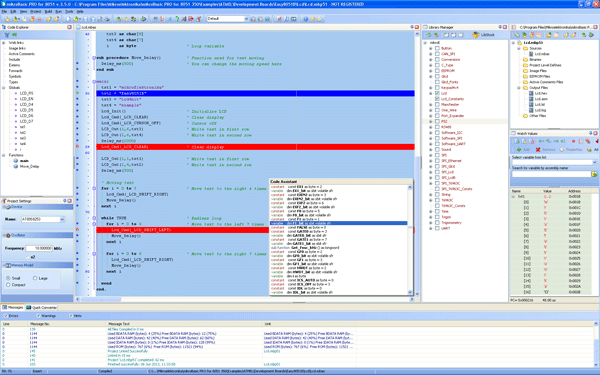Introduction to mikroBasic PRO for 8051
Help version: 2013/06/10
The mikroBasic PRO for 8051 is a powerful, feature-rich development tool 8051 microcontrollers. It is designed to provide the programmer with the easiest possible solution to developing applications for embedded systems, without compromising performance or control.

mikroBasic PRO for 8051 IDE
Features
mikroBasic PRO for 8051 allows you to quickly develop and deploy complex applications:
- Write your Basic source code using the built-in Code Editor (Code and Parameter Assistants, Code Folding, Syntax Highlighting, Spell Checker, Auto Correct, Code Templates, and more.)
- Use included mikroBasic PRO for 8051 libraries to dramatically speed up the development: data acquisition, memory, displays, conversions, communication etc.
- Monitor your program structure, variables, and functions in the Code Explorer.
- Generate commented, human-readable assembly, and standard HEX compatible with all programmers.
- Inspect program flow and debug executable logic with the integrated Software Simulator.
- Get detailed reports and graphs: RAM and ROM map, code statistics, assembly listing, calling tree, and more.
- mikroBasic PRO for 8051 provides plenty of examples to expand, develop, and use as building bricks in your projects. Copy them entirely if you deem fit – that’s why we included them with the compiler.
Where to Start
In case that you’re a beginner in programming 8051 microcontrollers, read carefully the 8051 Specifics chapter. It might give you some useful pointers on 8051 constraints, code portability, and good programming practices.
If you are experienced in Basic programming, you will probably want to consult mikroBasic PRO for 8051 specifics first. For language issues, you can always refer to the comprehensive Language Reference. A complete list of included libraries is available at mikroBasic PRO for 8051 Libraries.
If you are not very experienced in Basic programming, don’t panic! mikroBasic PRO for 8051 provides plenty of examples making it easy for you to go quickly. We suggest that you first consult Projects and Source Files, and then start browsing the examples that you're the most interested in.
What do you think about this topic ? Send us feedback!


